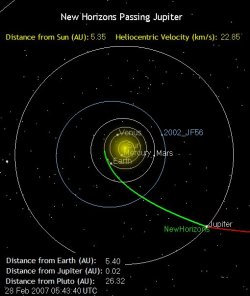 New Horizon: Trajectory Where Is New Horizon? Credit: NASA, JPL, APL |
Pluto, now contentiously classified as a dwarf planet, is member of a class of Kuiper Belt objects that include Eris (the largest – Pluto is second), Ceres, Haumea, and Makemake. The trouble began in the late 1970’s with the discovery of Chiron, one of the minor planets, a designation made obsolete in 2006 and now referred to as small solar system bodies. There are approximately 200,000 of these objects. They are not sufficiently massive to squeeze themselves into a spherical shape, which is one of the rules for being classified as a dwarf planet (you have to be round). Pluto has been studied extensively by telescope, but no spacecraft has flown by the planet. The New Horizons spacecraft was launched on a fast track (36,370 miles per hour) toward Pluto on 19 January 2006, using an Atlas V 551 first stage, a Centaur second stage and a STAR 48B solid rocket third stage. Flying at 51,000 miles per hour (about 23 kilometers per second – kps) during a gravity assist from Jupiter on 28 February 2007, New Horizons is expected to arrive at Pluto on 14 July 2015. During its flyby of Pluto and Charon, New Horizons will be traveling at 31,300 miles per hour (14 kps). |
New Horizons was designed, built and is operated by the Johns Hopkins University Applied Physics Laboratory (APL) for NASA, and the Jet Propulsion Laboratory (JPL), along with other research organizations.
The New Horizons spacecraft carries seven instruments for the exploration of Pluto and its moon Charon, and the Kuiper Belt objects it expects to encounter:
|
 New Horizon Instruments Credit: NASA, JPL, APL |
Why go to Pluto? Our solar system is composed of three groups of planets: the rocky worlds (Earth, Venus, Mercury and Mars); the gas giants (Jupiter, Saturn, Uranus and Neptune); and the ice dwarfs of the Kuiper Belt (Pluto, Eris, Makemake, Haumea, and Ceres along with 35 or more additional dwarf planets). Indeed there are many more ice dwarfs than major planets in the Solar System.
So far, no spacecraft has explored any of the ice dwarfs in the Kuiper Belt. This gap in our knowledge of the Solar System will begin to filled in by the instruments on board the New Horizons spacecraft:
The ice dwarfs are planetary embryos, whose growth stopped at sizes (200 to 2,000 kilometers across) much smaller than the full-grown planets in the inner solar system and the gas giants region. The ice dwarfs are ancient relics that formed over 4 billion years ago. Because they are literally the bodies out of which the larger planets accumulated, the ice dwarfs have a great deal to teach us about planetary formation.
 Trans Neptunian Objects Credit: NASA, Wikipedia Commons |
 True Color Image of Pluto by Eliot Young, Richard Binzel and Keenan Crane (NASA) |
 Pluto, Charon, Nix and Hydra Credit: APL |
